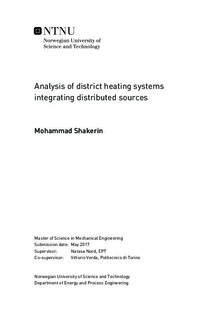Analysis of district heating systems integrating distributed sources
Abstract
Renewable energies sources are found to be the promising solution toward the prospect of environmental friendly and energy efficient societies. District heating systems play an important role concerning utilization of distributed renewable energy sources, as if national and international regulations are set for both decreasing heat energy demand and development of renewable energy production and efficient distribution in district heating and cooling systems. Waste heat from cooling datacentres and server aisles are considered to be reliable to utilize for district heating purposes, however there are still limitations in efficient integrating waste heat sources to main distribution networks. Therefore the aim of this study was to develop a general physical model of a district heating distribution network connected to various consumers and central heat production unit, able to carry bidirectional flow. Based on fundamental equations derived from continuum mechanics, two one dimensional models for hydraulic part and thermal part of the system was built. These models were coded in MATLAB software. As a case study district heating ring network of Gløshaugen campus of NTNU in Trondheim which has utilized the waste heat from a datacentre with annual 1 MW heat base load was used. Hourly quasi-static simulation of different cases which reflect different shares of integrating the waste heat source was done for analysing the network in presence of higher shares of distributed waste heat. Two scenarios were introduced in order to analyse and compare performance of the system when supply temperature and pumping system are controlled. The result showed that increasing contribution of waste heat source as a secondary heat provider could cause pressure balance problem in consumer substations near to it. However adopting variable speed control for the pump together with utilizing flow control valve at consumer substation could lower the pressure level within the network and decrease the pressure fluctuations near waste heat source. Lowering temperature levels lead to considerable heat energy saving in distribution pipes from 10% to 7%. Also average annual heat load and consequently annual energy obtained from the waste heat was significantly increased by 45%. Low temperature levels however was shown to have a drawback on the temperature of the heat harvested from the waste heat source and resulted in heat with up to 8°C lower temperature which is difficult to utilize. Despite of the assumptions and simplifications applied, the result still indicates main features, advantages and disadvantages of integrating waste heat sources.
